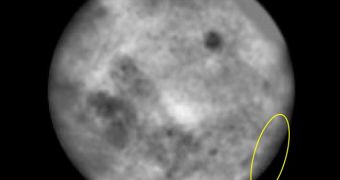The first images of the far side of the Moon were taken by the Russian Luna 3 and Zond 3 spacecraft in October 1959 and July 1965, respectively. These were the first to present the Moon's face that we never see, because of the fact that it has a rotation time around its axis equal to the revolution tine around Earth.
Now, amateur astronomer Ricardo Nunes re-processed the old blurry, shaky and noisy images and came up with a theory supporting the claims of V.V. Shevchenko and V.I.Chikmachev of the Sternberg State Astronomical Institute in Moscow, who claimed that a small dark spot visible on the Moon's surface in the images of the Luna 3 is actually part of the western edge of the enormous South Pole-Aitken Basin (SPAB).
The SPAB is the biggest impact crater in our solar system, having a diameter of 1,550 miles (2,500 kilometers) and a depth of 8 miles (12 kilometers). It spans between the Moon's South Pole and the crater Aitken.
Until now, the first recorded images of the SPAB were supposed to have been taken by the Galileo spacecraft, on its way to Jupiter.
The new images were digitally enhanced and improved, and now show the eastern side of the outer ring of mountains around the huge crater, that were produced 4.1 billion years ago, by the impact with an enormous asteroid. "The formation of SPAB was a huge event in early lunar history, and its influence was likely felt all across the Moon," said Lisa Gaddis of the Astrogeology Program at the U.S. Geological Survey. "Not only is SPAB the biggest 'hole' in our solar system, but it must have dug down deeply enough to expose and excavate materials from deep within the Moon."
Because of the fact that no one noticed the dark smudge visible on the Moon's limb on the original footage, the importance of the SPAB has been underrated and consequently, no mission has been concentrated on that area. "It would likely have changed lunar maps and our understanding of the occurrence and distribution of large impacts on terrestrial planets. It also might have influenced exploration or at least imaging of the far side at an earlier time," Gaddis said.

 14 DAY TRIAL //
14 DAY TRIAL //